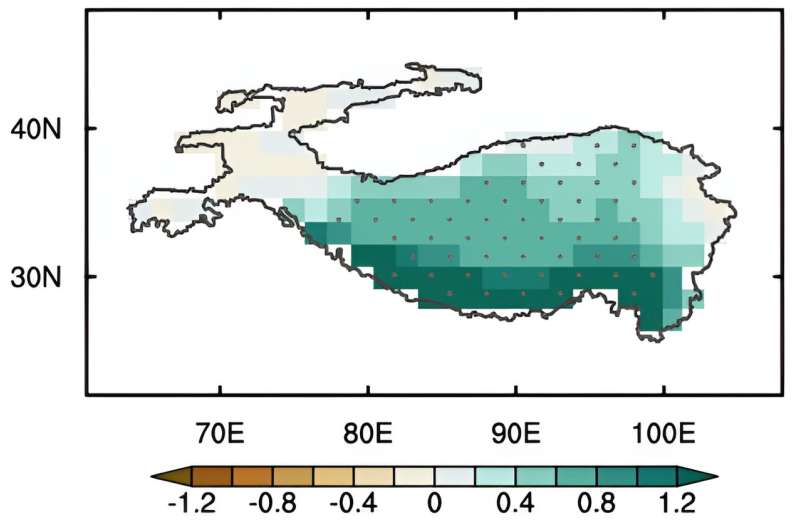This article has been reviewed according to Science X's editorial process and policies. Editors have highlighted the following attributes while ensuring the content's credibility:
fact-checked
trusted source
proofread
Understanding uncertainties in projected summer precipitation changes over the Tibetan Plateau

The Tibetan Plateau (TP), a complex high-altitude region with an average elevation of 4,000 meters, is widely recognized as the "Asian Water Tower" and "the third pole." Changes in precipitation over the TP significantly affect the water cycle in the surrounding areas, directly and indirectly affecting the lives of millions of people and ecosystems.
Despite extensive efforts to project future precipitation changes over the TP due to global warming, there remains a considerable range in the magnitude of existing projections. The underlying physics causing this inter-model spread in precipitation projections over the TP remains unclear. Therefore, gaining insight into the precipitation response to global warming and identifying sources of uncertainty are critical to improving the reliability of these projections.
In a study published in Geophysical Research Letters researchers highlighted the persistent increase in precipitation throughout the 21st century, with the most significant changes occurring along the southern edge of the TP. However, they found substantial inter-model variability in precipitation projections, emphasizing that model uncertainty dominates the overall uncertainty in the medium and long term.
Led by Prof. Zhou Tianjun from the Institute of Atmospheric Physics (IAP) of the Chinese Academy of Sciences, the researchers used an inter-model empirical orthogonal function analysis of projected precipitation changes under a very high greenhouse gas (GHG) emission scenario, referred to as "SSP5-8.5" in climate modeling.
The analysis showed that the leading principal component explains over 40%, and even 80%, of the total variance at regional scales. Moisture budget analysis indicated that the increase in precipitation is primarily driven by enhanced vertical thermodynamic (TH) responses to the increased water-holding capacity of the atmosphere, with a weak effect from the vertical dynamical (DY) term. However, both vertical DY and TH components contribute to the leading mode of inter-model spread in precipitation projections.
"The vertical TH component is significantly related to the climate sensitivity among the models involved in the phase-6 of the Coupled Model Intercomparison Project, suggesting that models projecting a warmer climate also tend to project a stronger TH term," said Qiu Hui, first author of the study and a Ph.D. student from the University of the Chinese Academy of Sciences.
The researchers further revealed that the inter-model spread of the dynamic component is influenced by the equatorial Pacific warming pattern through the Walker Circulation change, which controls diabatic heating over the Marine continent and leads to atmospheric circulation changes that affect northward moisture transport to the southern TPs.
"Both the model weighting technique and the selection of high skill models with better performance of historical climate simulation have been traditionally used to increase the robustness of climate projection in previous studies," said Prof. Zhou Tianjun, corresponding author of the study.
"Our results enrich the research by highlighting that the diversity in CMIP6 models projecting precipitation changes over the TP is not only related to local model performance, but is influenced by the overall performance of climate models in the context of climate sensitivity and the response of equatorial Pacific sea surface temperature to global warming."
The researchers also examined the relationship between the thermodynamic term and climate sensitivity under scenarios with low (termed as "SSP1-2.6") and intermediate (termed as "SSP2-4.5") GHG emissions, and found similar results to scenarios with very high GHG emissions.
They call for further research into the inter-model variability of the response of equatorial Pacific Sea Surface Temperature to global warming.
More information: Hui Qiu et al, Understanding the Diversity of CMIP6 Models in the Projection of Precipitation Over Tibetan Plateau, Geophysical Research Letters (2024). DOI: 10.1029/2023GL106553
Provided by Chinese Academy of Sciences




















